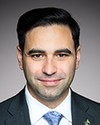Thank you very much to members of the committee for inviting the Canadian Council for International Cooperation to appear before you on this study on countries of focus. As Mr. Nault and Jim have mentioned, the study is very timely, given the launch yesterday of the international policy review.
As many of you know, CCIC is Canada's national association of civil society organizations or CSOs, working globally to achieve sustainable human development. Our 80-plus members represent a broad range of CSOs working on international development and humanitarian assistance, from faith-based and secular organizations to co-operatives and unions to professional associations.
I want to go straight to discussing the study, the countries of focus, and their effectiveness.
To have impact on anything, some degree of focus is necessary. Canada now has 25 countries of focus, and this reduced number of country-to-country partnerships, a shifting from I think around 47 countries to 25, was in fact welcomed by the OECD when it conducted its peer review in 2012 of Canada.
However, as members of this committee know, the geography of poverty has shifted. Poverty is pervasive not just in low-income countries but also in low- and upper-middle-income countries. In fact, many estimate, and I think somebody referenced this in committee hearings on Tuesday, that around 70% of the world's poor live in middle-income countries. Furthermore, inequality is getting worse, both within and between countries.
What are the implications of this and other considerations for this study? I have 10 brief points that I would like to make for the committee to consider.
First, there is no perfect mix of countries. In my perspective, Canada has a well-balanced mix of fragile states, least-developed countries, and low-income and middle-income countries. From our perspective, don't change it, but do learn from it.
As I think Jim has suggested and maybe CARE the other day, the committee, for example, could recommend to Global Affairs Canada to conduct an ongoing monitoring and evaluation of the countries-of-focus model, highlighting outcomes both intended and unintended. As far as I'm aware, nothing of that type has been done to date.
Equally, we might want to go further and give some thought to how we engage with regional institutions, so that our efforts in countries of focus are reinforced by these regional synergies—such synergies are important, and this is a point that came up, I think—ensuring that, since countries operate also in regions and sub-regions, we ask how we can ensure that there's stability and security in those regions and that our efforts in countries aren't lost by regional instability.
Second, as Jim and many others have pointed out, the focus of our efforts should be less on poor countries and more on poor people, regardless of where they live. In fact, as Jim has also noted, the principal purposes of Canada's official development assistance as defined by the Official Development Assistance Accountability Act are to reduce poverty, to promote international human rights and their realization, and to respond to the voices of the poor.
This focus is consistent with the minister's mandate to focus on reducing poverty and inequality and also consistent with the newly created Office of Human Rights, Freedoms, and Inclusion that was announced yesterday.
Third, as the new 2030 agenda for sustainable development in the sustainable development goals or SDGs has signalled, we must leave no one behind. This means that we must focus our efforts not just on poor people but on the poorest and most marginalized: women and girls, people with disabilities, indigenous people, the urban and rural poor, and the people who are discriminated against because of their caste, religion, ethnicity, or age. Again this is consistent with the minister's mandate.
Fourth, a thematic focus may be helpful, but our priorities must be self-reinforcing, both within our approach to development in the framework of the sustainable development goals, but also within the department, in all of Global Affairs Canada, and across government. The new SDGs challenge us to move outside of our silos, pushing for both stand-alone goals and cross-cutting objectives, such as on women's rights and gender equality and, I would argue also, on climate change. This will require new ways of working and thinking, new collaboration and partnerships, in a whole-of-government, whole-of-Canada strategy, if you will. Our development endeavours must be reinforced, not undermined, by our diplomatic and trade efforts.
Fifth, we must be responsive to people's needs and realities. A focus on specific countries or themes should not be to the exclusion of evolving human needs. Regardless of the focus chosen, there should always be some flexibility to account for unanticipated developments.
How? I would suggest that the government should work with a diverse range of actors in developing and implementing Canada's international assistance. If, for example, Canada's multilateral approach is to support cohesion and stability at a regional level, its bilateral approach could be more focused and directive, along the lines that Jim was suggesting, and then its approach to civil society could be more flexible and responsive. This is also in keeping with the government's civil society partnership policy.
What we need, then, is a diversified portfolio of tools and approaches that will reduce risk and enhance efficiency in our response.
Sixth, and this is very important, it's about their priorities, not ours. Alignment with developing country priorities, democratic ownership of these priorities, and harmonization of our efforts with other donors have been recognized over the past 15 years as key determinants of effective delivery of aid. Developing country governments and their CSOs are generally best placed to understand the realities of their own citizens.
We need to support their solutions, not promote ours. Yet Canada's 2012 peer review by the OECD noted how far Canada had fallen from aligning its support to the priorities of the countries in which it was operating. That same year, Canada allowed its aid effectiveness action plan to conclude without developing a new one.
We need a new action plan, and we need country partners, not us, to lead the way in defining their priorities for implementing the sustainable development goals.
Seventh, it's not just about governments. The 2030 agenda has emphasized that all development actors have a role to play—civil society, parliamentarians, local government, the private sector. Accordingly, Canada must rebalance the recipients of Canadian ODA or aid away from the strong bias in favour of multilateral institutions of recent years towards a clear balance between multilateral, bilateral, and civil society, among others. In fact, in its 2012 peer review the OECD underscored the importance of strengthening civil society organizations in Canadian countries of focus.
Eighth, and again I can't underscore this enough, ensure predictability. This speaks to my point about there being no perfect mix. Let's stick with our existing mix of countries. In recent years, frequent shifts in the countries of focus, in my view, have made Canada a liability. Sustained and long-term investments in partners will not only generate greater impacts but will generate greater predictability. As the OECD has noted, such predictability can allow Canada to support the reform and strengthening of country systems so as to improve the management of public administration and public funds more broadly.
Ninth, bring the Canadian public along. Investments in public engagement and a strategy for the government will not only help connect this universal SDG agenda for the world with Canadian realities, but will build the public's understanding of the complexity of international development and in turn build their support for our endeavours.
Tenth, and this is my final point, walk the talk. Greater impact comes not only with greater country or thematic focus, alignment, and responsiveness, but with increased and targeted investments that reflect Canada's ambitions. In 2014 Canada was among the top three donors in just nine of its 25 countries of focus. We've calculated that an additional $60 million could make Canada a top three donor in half of its countries of focus, based on 2014 numbers. Similarly, if women's rights is a priority, you might be surprised to learn that Canada dedicated only $5 million per year to women's rights organizations in 2014. By contrast, that same year Norway dedicated $120 million.
To summarize, the countries-of-focus model is one tool by which Canada can focus its bilateral international assistance partnerships, but as with any tool, we need to use the model well in order to maximize its effectiveness. It should be a tool that is balanced with other tools, issues, and players in multilateral efforts that can address regional needs and dynamics as well as with responsive programming that can be championed by civil society partners.
Our overarching emphasis must be upon reducing poverty and inequality, upon the poorest and most marginalized, and upon people—their needs, their rights, their assets, their abilities, and their priorities.
We must be consistent and predictable as well as flexible in our approach, and we must match our policy priorities across the government both at home and overseas to our practice with commensurate investments in countries, institutions, themes, and above all people.
Thank you for listening. I look forward to your questions.



